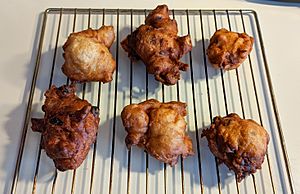Oliebol facts for kids
 |
|
| Type | dumpling |
|---|---|
| Place of origin | Belgium and Netherlands |
| Main ingredients | Flour, eggs, yeast, some salt, milk, baking powder; usually sultanas, currants, raisins; zest or succade |
| Variations | Appelbeignet |
An oliebol is a yummy, traditional fried dough snack. It's like a special kind of doughnut or dumpling. People in Belgium and the Netherlands love to eat them.
The word "oliebol" means "oil ball" in Dutch. In some places, they are also called "smoutebollen," which means "lard balls." This is because they were often cooked in animal fat a long time ago. You might also hear them called "Dutch doughnuts" or "dutchies" in English.
Contents
What is an Oliebol?
Oliebollen are a type of dumpling that are deep-fried. To make them, bakers use a scoop or two spoons. They drop a special dough into hot oil. This makes the dough puff up into a round shape.
These tasty treats are a big part of celebrations. People traditionally eat them on New Year's Eve. You can also find them at funfairs. During winter, many street stalls sell them fresh and hot.
Ingredients and Serving
The dough for oliebollen is made from simple ingredients. These include flour, eggs, yeast, a little salt, milk, and baking powder. Many recipes add sultanas, currants, or raisins. Sometimes, they also include lemon zest or succade (candied fruit).
A special type is the appelbeignet. This one has a slice of apple inside. Unlike regular oliebollen, its dough doesn't need to rise for a long time. Oliebollen are usually served warm. They are often dusted with lots of powdered sugar on top.
Dutch vs. Flemish Oliebollen
In Flanders, which is part of Belgium, the "oliebol" is often called a "smoutebol." This is because it used to be cooked in animal fat, like lard, instead of vegetable oil.
There's another difference too. Dutch oliebollen often have fillings like raisins, currants, or apple. Sometimes, they even have pieces of orange or whipped cream. But Flemish smoutebollen are usually plain inside.
History of Oliebollen
The exact start of oliebollen is a bit of a mystery. Some people think that ancient Germanic tribes first ate them. This was during the Yule period, which is between December 26 and January 6. They might have used these fried dough treats in their winter celebrations.
Another idea is that they came to the Netherlands in the 1400s. This could have been from Portuguese Jewish people who moved there. The oliebol might be related to the Jewish sufganiyah. This is a similar fried dough eaten during Hanukkah.
The oldest known recipe for a treat like this is from 1667. It was in a Dutch cookbook called De verstandige kock ("The sensible cook"). Back then, they were called oliekoecken, meaning "oil cookies."
From Oil Cookie to Oil Ball

For many centuries, people in the Netherlands ate oliekoek. This was the old name for what we now call oliebol. A painting from around 1652 shows oliebollen that look very much like the ones today. In those days, they were cooked in lard or rapeseed oil.
Around the 1800s, the word "oliebol" started to become more common. By the early 1900s, "oliebol" was the popular name. The older term "oliekoek" was hardly used anymore.
Croustillons: A Belgian Cousin
A very similar fried dough treat is found in Wallonia, Brussels, and northern France. These are called croustillons. They are also deep-fried dough balls. They are served hot and covered with lots of powdered sugar.
You usually get croustillons in a paper cone. They come with a small plastic fork to help you eat them. You can often find them at fairgrounds in Belgium and in cities like Lille in France.
Oliebollentest Contest
For many years, a Dutch newspaper called Algemeen Dagblad held a yearly oliebollentest. This contest happened at the end of each year. Bakers from all over the country would enter their oliebollen. Judges would taste them and pick the best one.
One baker, Richard Visser, won the contest nine times in twenty years! This is still the record for the most wins. The contest stopped in 2018. However, many fans of oliebollen still review them on their own. They share their ratings on a special website.
See also
 In Spanish: Oliebollen para niños
In Spanish: Oliebollen para niños


